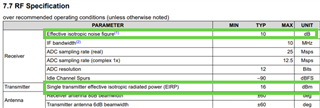Other Parts Discussed in Thread: AWR1843, , AWR1843BOOST
Hi,
We have been trying to do a link-budget comparing the 1843 to the 1843AOP and noticed that
A) The transmit power between the two have a 6dB delta [1843Boost = 10dbm vs AOP = 16dbm]
B) The noise figure with the AOP is ~6dB lower than the 1843boost
Could anyone help clarify what is different between the two boards (from an RF standpoint) that is driving these differences?



